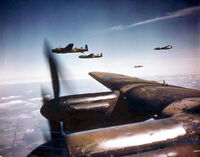
Lancaster B Mk.I of No. 50 Squadron RAF ased at Skellingthorpe, flying in spread formation in June 1944.
The Avro Lancaster is a British four-engined Second World War heavy bomber designed and built by Avro for the Royal Air Force (RAF). It first saw active service with RAF Bomber Command in 1942 and, as the strategic bombing offensive over Europe gathered momentum, it became the main heavy bomber used by the RAF, the RCAF, and squadrons from other Commonwealth and European countries serving within the RAF, overshadowing its close contemporaries the Handley Page Halifax and Short Stirling. The "Lanc", as it was affectionately known, thus became one of the more famous and most successful of the Second World War night bombers.
The Lancaster, an evolution of the troublesome Avro Manchester, was designed by Roy Chadwick and was powered by four Rolls-Royce Merlins, or, in one version, Bristol Hercules engines.
A long, unobstructed bomb bay meant that the Lancaster could take the largest bombs used by the RAF, including the 4,000 lb (1,800 kg), 8,000 lb (3,600 kg), and 12,000 lb (5,400 kg) blockbusters, loads often supplemented with smaller bombs or incendiaries. The versatility of the Lancaster was such that it was chosen to equip 617 Squadron, and was modified to carry the Barnes Wallis-designed Upkeep "Bouncing Bomb" for Operation Chastise, the attack on Germany's Ruhr Valley dams. Although the Lancaster was primarily a night bomber, it excelled in many other roles, including daylight precision bombing: in the latter role some Lancasters were adapted to carry the 12,000 lb (5,400 kg) Tallboy and, ultimately, the 22,000 lb (10,000 kg) Grand Slam earthquake bombs (also designed by Wallis).
As early as 1943, a Lancaster was converted to become an engine test bed for the Metropolitan-Vickers F.2 turbojet. Lancasters were later used to test several different engines, including the Armstrong Siddeley Mamba and Rolls-Royce Dart turboprops, and the Avro Canada Orenda and STAL Dovern turbojets. Postwar, the Lancaster was supplanted as the RAF's main strategic bomber by the Avro Lincoln, itself a larger permutation of the Lancaster. Instead the Lancaster took on the role of long range anti-submarine patrol aircraft (later supplanted by the Avro Shackleton) and air-sea rescue. It was also used in roles as diverse as photo-reconnaissance and aerial mapping, as a flying tanker for aerial refueling, and as the Avro Lancastrian, a long-range, high-speed transatlantic passenger and postal delivery airliner. In March 1946, a Lancastrian of BSAA flew the first scheduled flight from the then new London Heathrow Airport.
Users
 Arabia
Arabia
 Argentina
Argentina
 Australia
Australia
 Brazil
Brazil
 British Empire
British Empire
 Canada
Canada
 Republic of China
Republic of China
 Czechoslovakia
Czechoslovakia
- Czechoslovak Air Force
 Denmark
Denmark
 Dominican Republic
Dominican Republic
 Egypt
Egypt
 France
France
 Nazi Germany
Nazi Germany
- Luftwaffe - as Beuteflugzeug (captured aircraft)
 Iran
Iran
 Israel
Israel
 Republic of Japan
Republic of Japan
 Netherlands
Netherlands
 New Zealand
New Zealand
 Poland
Poland
 Portugal
Portugal
 Romania
Romania
 South Africa
South Africa
 Sweden
Sweden
 Switzerland
Switzerland
 Turkey
Turkey
See Also
Related Development
- Avro Lancastrian
- Avro Lincoln
- Avro Lincolnian
- Avro Shackleton
- Avro York
Comparable Aircraft
 Buffalo AF B-24/41
Buffalo AF B-24/41 Focke-Wulf Fw-200
Focke-Wulf Fw-200 Handley Page Halifax
Handley Page Halifax Heinkel He-177
Heinkel He-177 Messerschmitt Me-264
Messerschmitt Me-264 Nakajima G5N Shinzan
Nakajima G5N Shinzan Petlyakov Pe-8
Petlyakov Pe-8 Piaggio P.108 Bombardiere
Piaggio P.108 Bombardiere Seattle AF B-17/38
Seattle AF B-17/38 Short Stirling
Short Stirling Supermarine Southampton
Supermarine Southampton Vickers Windsor
Vickers Windsor